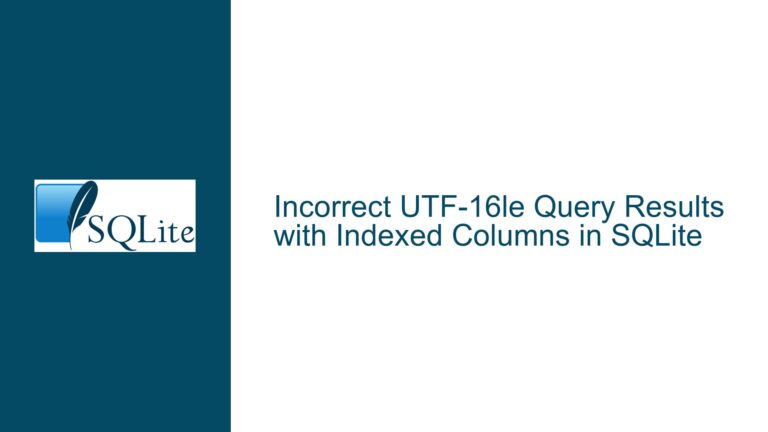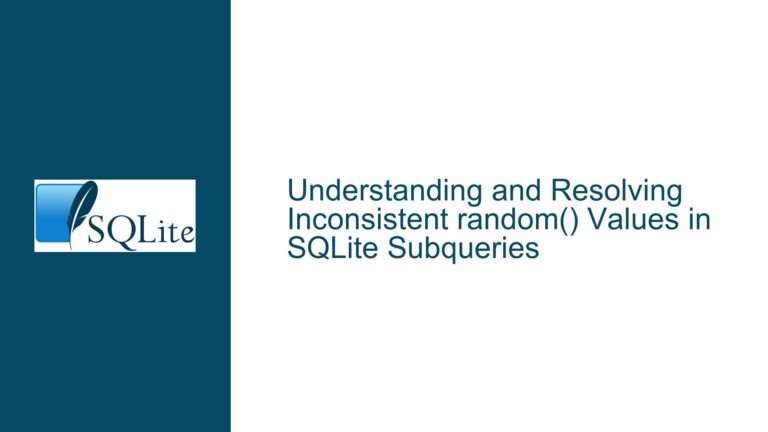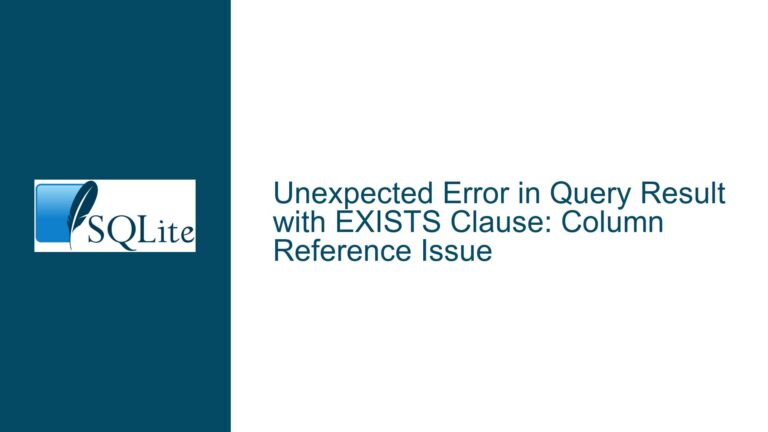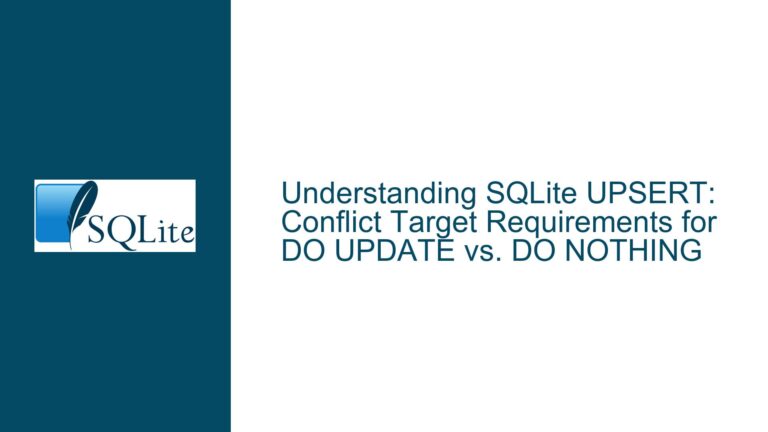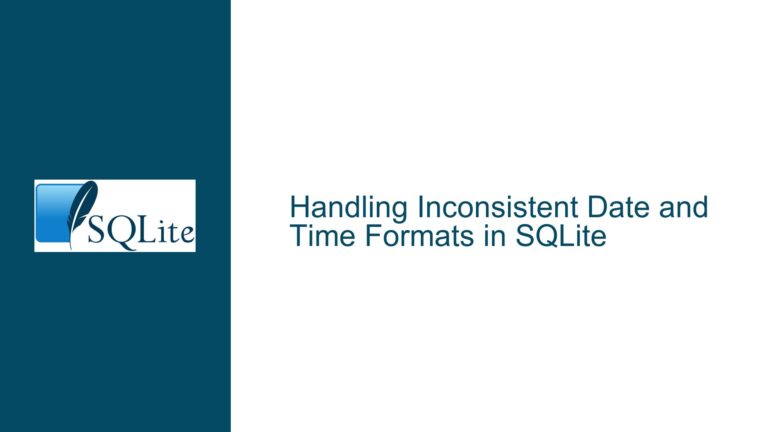Enhancing SQLite Recursive CTEs with Window Function Support
Recursive CTEs and Window Functions: A Powerful Combination
Recursive Common Table Expressions (CTEs) and window functions are two of the most powerful features in modern SQL databases. Recursive CTEs allow for the execution of recursive queries, which are essential for hierarchical or graph-based data structures. Window functions, on the other hand, provide a way to perform calculations across a set of table rows that are somehow related to the current row. While many databases, such as PostgreSQL and DuckDB, support the use of window functions within recursive CTEs, SQLite currently lacks this capability. This limitation can be a significant hurdle for developers who need to perform complex recursive calculations that involve window functions.
The absence of window function support in recursive CTEs in SQLite can lead to inefficiencies and workarounds that complicate queries and reduce performance. For instance, developers might need to split a single query into multiple steps, use temporary tables, or even resort to application-level logic to achieve the desired results. These workarounds not only increase the complexity of the code but also make it harder to maintain and debug.
Understanding the Limitations and Implications
The core issue lies in the way SQLite handles recursive CTEs and window functions. In SQLite, recursive CTEs are designed to work with a fixed set of columns and rows, and the engine does not support the dynamic nature of window functions within these CTEs. Window functions, by their very nature, require the ability to look ahead or behind the current row to perform calculations, which is not compatible with the current implementation of recursive CTEs in SQLite.
This limitation becomes particularly evident when trying to perform calculations that require both recursion and windowing. For example, consider a scenario where you need to calculate a running total or a cumulative sum within a recursive query. In databases that support window functions in recursive CTEs, this can be achieved with a single query. However, in SQLite, you would need to break down the problem into multiple steps, potentially using temporary tables or nested subqueries, which can be both cumbersome and inefficient.
The lack of support for window functions in recursive CTEs also affects the portability of SQL code. Developers who are accustomed to using these features in other databases may find it challenging to migrate their queries to SQLite. This can lead to a situation where the same logic needs to be implemented differently depending on the database being used, increasing the risk of errors and inconsistencies.
Exploring Potential Solutions and Workarounds
While SQLite does not currently support window functions in recursive CTEs, there are several strategies that developers can employ to work around this limitation. One approach is to use temporary tables to store intermediate results. By breaking down the recursive query into multiple steps and storing the results in temporary tables, you can effectively simulate the behavior of window functions within a recursive CTE.
Another approach is to use nested subqueries to achieve the desired results. Although this can lead to more complex and less readable queries, it can be an effective way to perform calculations that would otherwise require window functions. For example, you can use a subquery to calculate the running total or cumulative sum and then join the results back to the main query.
In some cases, it may be possible to rewrite the query to avoid the need for window functions altogether. This can involve rethinking the logic of the query and finding alternative ways to achieve the same result. For example, instead of using a window function to calculate a running total, you might be able to use a recursive CTE to accumulate the total as you go.
Finally, it is worth considering whether SQLite is the right database for the task at hand. While SQLite is an excellent choice for many applications, there are situations where a more feature-rich database, such as PostgreSQL or DuckDB, might be a better fit. If your application requires advanced SQL features like window functions in recursive CTEs, it may be worth exploring other database options.
Detailed Troubleshooting Steps and Solutions
Step 1: Identifying the Need for Window Functions in Recursive CTEs
The first step in addressing the issue is to clearly identify the need for window functions within a recursive CTE. This involves understanding the specific calculations or operations that require both recursion and windowing. For example, if you need to calculate a running total or a cumulative sum within a recursive query, this is a clear indication that window functions are needed.
Once you have identified the need, you should document the specific requirements and constraints of the query. This includes the structure of the data, the desired output, and any performance considerations. Having a clear understanding of the problem will help you choose the most appropriate solution.
Step 2: Evaluating Alternative Approaches
With the requirements in hand, the next step is to evaluate alternative approaches that can achieve the same result without using window functions in recursive CTEs. This involves exploring different SQL techniques and patterns that can be used to simulate the behavior of window functions.
One approach is to use temporary tables to store intermediate results. By breaking down the recursive query into multiple steps and storing the results in temporary tables, you can effectively simulate the behavior of window functions. For example, you can use a temporary table to store the cumulative sum at each step of the recursion and then join the results back to the main query.
Another approach is to use nested subqueries to perform the necessary calculations. Although this can lead to more complex and less readable queries, it can be an effective way to achieve the desired results. For example, you can use a subquery to calculate the running total or cumulative sum and then join the results back to the main query.
In some cases, it may be possible to rewrite the query to avoid the need for window functions altogether. This can involve rethinking the logic of the query and finding alternative ways to achieve the same result. For example, instead of using a window function to calculate a running total, you might be able to use a recursive CTE to accumulate the total as you go.
Step 3: Implementing the Chosen Solution
Once you have evaluated the alternative approaches and chosen the most appropriate solution, the next step is to implement it. This involves writing the SQL code, testing it, and optimizing it for performance.
If you have chosen to use temporary tables, you will need to create the tables, populate them with the intermediate results, and then join them back to the main query. It is important to ensure that the temporary tables are properly indexed and that the joins are optimized for performance.
If you have chosen to use nested subqueries, you will need to carefully structure the queries to ensure that they are efficient and easy to understand. This may involve breaking down the query into smaller, more manageable pieces and testing each piece individually.
If you have chosen to rewrite the query to avoid the need for window functions, you will need to carefully test the new logic to ensure that it produces the correct results. This may involve running the query on a sample dataset and comparing the results to the expected output.
Step 4: Testing and Validation
After implementing the chosen solution, the next step is to thoroughly test and validate the query. This involves running the query on a representative dataset and verifying that it produces the correct results. It is also important to test the query for performance, especially if it involves large datasets or complex calculations.
If the query does not produce the expected results, you may need to revisit the implementation and make adjustments. This could involve tweaking the logic, optimizing the joins, or re-evaluating the choice of solution.
If the query performs poorly, you may need to optimize it further. This could involve adding indexes, restructuring the query, or using more efficient SQL techniques. It is important to monitor the performance of the query and make adjustments as needed.
Step 5: Documenting the Solution
Finally, it is important to document the solution for future reference. This includes documenting the problem, the chosen solution, and the steps taken to implement and test the solution. This documentation will be valuable for other developers who may need to work with the query in the future, as well as for troubleshooting and maintenance purposes.
The documentation should include a clear explanation of the problem, the rationale for choosing the solution, and any potential pitfalls or limitations. It should also include the SQL code, along with any relevant comments or annotations. This will help ensure that the solution is well-understood and can be easily maintained or modified in the future.
Conclusion
While SQLite does not currently support window functions in recursive CTEs, there are several strategies that developers can employ to work around this limitation. By understanding the problem, evaluating alternative approaches, and carefully implementing and testing the chosen solution, developers can achieve the desired results without compromising on performance or maintainability.
It is also worth considering whether SQLite is the right database for the task at hand. If your application requires advanced SQL features like window functions in recursive CTEs, it may be worth exploring other database options. However, for many applications, SQLite remains an excellent choice, and with the right approach, it is possible to overcome its limitations and achieve the desired results.

